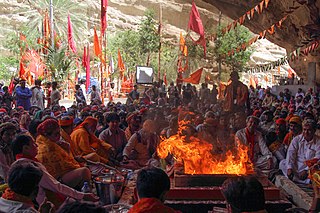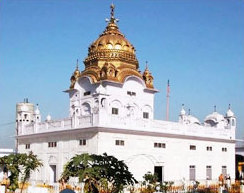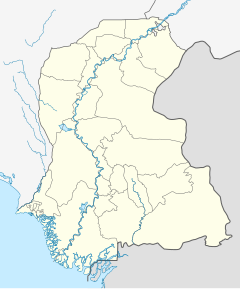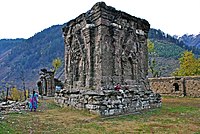
Vaisakhi, also known as Baisakhi, marks the first day of the month of Vaisakh and is traditionally celebrated annually on 13 April and sometimes 14 April. It is seen as a spring harvest celebration primarily in Punjab and Northern India. Whilst it is culturally significant as a festival of harvest, in many parts of India, Vaisakhi is also the date for the Indian Solar New Year.
Pakistan has five major ethno-regional communities in Pakistan: Baloch, Muhajir, Punjabis, Pushtuns and Sindhis, as well as several smaller groups. There are also religious and sectarian groups such as Ahmadis, Christians, Hindus, Kalasha, Parsis and Sikhs, and Shia Muslim sects including Ismailis and Bohras.

Hinduism is the second largest religious affiliation in Pakistan after Islam. Though Hinduism was one of the dominant faiths in the region a few centuries ago, Hindus accounted for just 2.17% of Pakistan's population in the 2023 Pakistani census. The Umerkot district has the highest percentage of Hindu residents in the country at 54.6%, while Tharparkar district has the most Hindus in absolute numbers at 811,507.

Udasis, also spelt as Udasins, also known as Nanak Putras, are a religious sect of ascetic sadhus centred in northern India who follow a tradition known as Udasipanth. Becoming custodians of Sikh shrines in the 18th century, they were notable interpreters and spreaders of the Sikh philosophy during that time. However, their religious practices border on a syncretism of Sikhism and Hinduism, and they did not conform to the Khalsa standards as ordained by Guru Gobind Singh. When the Lahore Singh Sabha reformers, dominated by Tat Khalsa Sikhs, would hold them responsible for indulging in ritual practices antithetical to Sikhism, as well as personal vices and corruption, the Udasi mahants were expelled from the Sikh shrines.

Ghotki District is a district of the province of Sindh, Pakistan, with headquarter in the city of Mirpur Mathelo. Prior to its establishment as a district in 1993, it formed part of Sukkur District.

Nagarparkar, is a tehsil in at the base of the Karoonjhar Mountains in Tharparkar District in Sindh province of Pakistan. The historic Churrio Jabal Durga Mata Temple is situated here. The taluka is located at a distance of 129 km from Mithi, in Sindh, Pakistan.

Kartarpur is a town located, just 102 km from Lahore city in the Shakargarh Tehsil, Narowal District in Punjab, Pakistan. Located on the right bank of the Ravi River, it is said to have been founded by the first guru of Sikhism, Guru Nanak, where he established the first Sikh commune.

Nanakpanthi, also known as Nanakshahi, is a Sikh sect which follows Guru Nanak (1469-1539), the founder of Sikhism.

Sadh Belo, also spelt as Sadh Bela, or Sat, is an island in the Indus River near Sukkur, Sindh, Pakistan that is famous for its highly revered Hindu temples. The temples are associated with the syncretic Udasi movement of Sikhism. The island is famous for Teerath Asthan which is the biggest Hindu temple in Pakistan. The complex has eight other temples, a library, dining areas, a huge garden, along with rooms and residences for monks and people who want to stay on the island on a spiritual retreat.
Raherki, also spelled Rahirki, is a village in the Sindh province of Pakistan. It is located along the N-5 National Highway, and lies about 5 kilometres (3.1 mi) away from the city of Daharki. The Mahi Wah river runs through the centre of the village.
Mirpur Mathelo is a city in Ghotki District, Sindh province, Pakistan. The city is administratively subdivided into ten union councils. It is the 97th largest city in Pakistan. It is also the location of the archaeological site, Moomal Ji Mari.

The Shri Swami Narayan Mandir, Karachi is a Hindu temple that is the only Swami Narayan temple in Pakistan. The temple is notable for its size and frontage, over 32,306 square yards (27,012 m2) on the M. A. Jinnah Road in Karachi city. The temple celebrated its anniversary of 216 years in April 2004. There is a sacred cowshed within the premises of this temple. The temple is located at the centre of a Hindu neighbourhood in Karachi. The building that housed a dharmshala for visiting devotees has now been converted to the office of the City District Government.

Mirpur Mathelo Tehsil is an administrative subdivision (tehsil) of Ghotki District in the Sindh province of Pakistan. It is administratively subdivided into ten Union Councils, two of which form the capital Mirpur Mathelo. It is headquarters of Ghotki district. The historic Shadani Darbar is located in Mirpur Mathelo Taluka.

Gurdwara Darbar Sahib Kartarpur, also called Kartarpur Sahib, is a gurdwara in Kartarpur, located in Shakargarh, Narowal District, in the Punjab province of Pakistan. It is built on the historic site where the founder of Sikhism, Guru Nanak, settled and assembled the Sikh community after his missionary travels and lived for 18 years until his death in 1539. It is one of the holiest sites in Sikhism, alongside the Golden Temple in Amritsar and Gurdwara Janam Asthan in Nankana Sahib.

Umarkot Shiv Mandir, also known as Amarkot Shiv Mandir, is a Hindu temple situated in Umerkot District, near Rana Jaageer Goth, in Sindh Province of Pakistan. This temple is perhaps the oldest in Sindh. The temple is one of the most sacred Hindu places of worship in the Sindh

The Kartarpur Corridor is a visa-free border crossing and religious corridor, connecting the Gurdwara Darbar Sahib, near Narowal in Pakistan to Gurudwara Dera Baba Nanak, Gurdaspur district, Punjab, India. The crossing allows devotees from India to visit the gurdwara in Kartarpur, Pakistan, 4.7 kilometres from the India–Pakistan border on the Pakistani side without a visa. However, Pakistani Sikhs are unable to use the border crossing, and cannot access Dera Baba Nanak on the Indian side without first obtaining an Indian visa or unless they work there.
The Protocol on Visits to Religious Shrines 1974 is a bilateral agreement between India and Pakistan facilitating Indian and Pakistani nationals to visit certain religious shrines in both countries. As of November 2018, fifteen locations in Pakistan and five in India are covered under this protocol.

The Kalka Devi Temple, Kalka Devi Cave Temple or Kalka Devi Mandir is one of the holiest Hindu temples in Pakistan. It is situated inside a natural cave in the Kalka hills in Aror, Sindh province, Pakistan. The temple is known as the Asthan of Kalka Devi. It is visited by both Hindus and Muslims. Hindus from India also visit. The majority of devotees visiting the temple are Muslims.


















